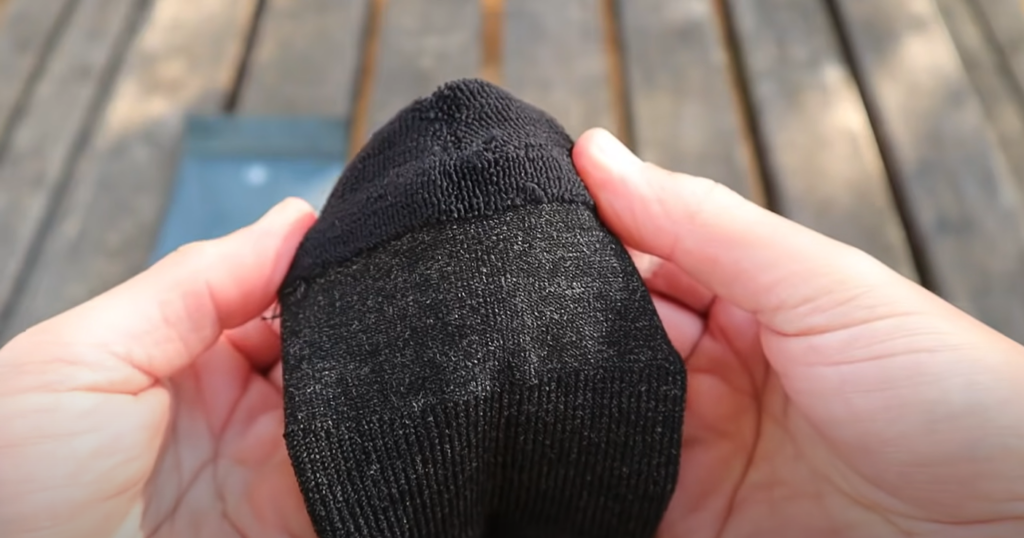If you get blisters while hiking, I must tell you that this is not a normal thing. There are several reasons why blisters may occur, but most of the time it is due to inappropriate footwear or socks. In this post, we’ll take a deeper dive into choosing the best socks for walking.
Choose socks that absorb sweat well and wick it away from the skin. Sweat that accumulates on the skin accelerates the foot rubbing against the shoe, which is the main reason why blisters form. The best sock material is wool/synthetic blend.
When choosing socks for walking and hiking, there are 5 points to tick if you want to prevent blisters while walking:
- absorb and wick sweat away from the skin,
- contain silver thread,
- have a seamless design,
- are additionally cushioned,
- are adapted for right and left foot.
At the end of this post, I’ll reveal the 7 best walking socks of my choice.
5 features your walking socks need to prevent blisters
The best walking socks are those that keep your feet dry even on longer hikes. Socks need to fit the foot well when walking, keep us cool in hot weather and warm in cold bustle. Most importantly, they must be comfortable enough.
Above I mentioned the 5 features a sock must have to keep us dry when walking. Let’s look at each feature individually to help you understand how the best walking socks are made to prevent blisters.
absorb and wick sweat away from the skin
The main cause of blisters is the wet environment created in the shoe by perspiration. Wet feet and socks cause friction, which increases the rubbing of the foot against the shoe or between the toes. Therefore, walking socks should be made of materials that absorb and wick away perspiration to keep the foot dry for longer.
The best material for socks is a mixture of wool and synthetic fibres. Wool (merino wool is best) is comfortable and absorbs a lot of sweat and yet remains dry to the touch. As it is a natural material it does not retain bacteria and therefore has no unpleasant odor. When choosing any sports socks, the composition of the socks should be at least 60% natural materials. For walking socks, merino wool is the best, and it is also the main component of the 7 best walking socks of my choice, which I present to you at the end of this post.

Synthetic fibres (nylon and polyester/CoolMax) help to make the sock more elastic, breathable and better fit the foot. In my opinion, nylon is the best synthetic material for sports socks. Because it is durable and absorbs a lot of moisture, which further helps to keep feet dry while walking.
Avoid wearing cotton socks during hikes and longer walks. Cotton absorbs a lot of sweat and dries very slowly, which makes it too wet. The foot will therefore be in a wet environment all the time, which is a guarantee for blisters. I suggest you read about the main differences between walking socks and regular socks.
Walking socks should contain silver thread
Silver thread is added to walking socks because silver kills bacteria. This is especially useful for longer hikes where the foot is in a dark and damp place for hours, which are ideal conditions for the spread of bacteria, fungi and micro-organisms. Dirty skin is also more prone to blisters, abrasions and irritated skin.

walking socks should have a seamless design
The highest quality walking socks have a seamless design that makes the sock more comfortable as the foot does not rub against the seam.

If you wear socks with seams, you may get blisters on the top of your toes, which is not uncommon. Because when you walk, the top of the socks rub against the top of your foot. The seams are a rough and uneven surface, which causes friction and pressure points on the foot that cause blisters.
walking socks are additionally cushioned
Walking socks need to be comfortable, so wool is the best material for such socks because it has thick fibres and is therefore very comfortable. For even more comfort, I suggest you choose socks that have extra padding in the toe and heel area. These two areas are where most of the friction is, and this is why blisters often occur.

Some hikers also like to wear two pairs of hiking socks to protect them from blisters and make them more comfortable. Two pairs of socks are also more absorbent, which will keep your feet dry for longer. Read more about what you need to know about wearing two pairs of hiking socks here.
walking socks are adapted for right and left foot
The left and right foot are different. They are effectively mirror images of each other, so the classic sock shape does not fit perfectly around your foot. For longer walks and hikes, it is recommended to choose walking socks that are adapted to the left and right foot, this way you achieve maximum comfort.
Is it better to walk barefoot or with socks?
Wearing socks brings many benefits: extra comfort when walking, reduces the rubbing against the shoe, absorbing and wicking sweat away from the skin, and preventing bacteria and fungi from forming on the skin. Not wearing socks when walking not only affects the comfort, but also affects the health of our feet.
Socks play an important role in comfort when walking. It is even advisable to wear cushioned socks for longer walks to alleviate pressure on the heels and toes. Even if you wear barefoot shoes, I advise you to always wear socks when walking. As well as being comfortable, socks also keep your feet healthy by absorbing sweat and wicking it away from the skin. This keeps your feet dry for longer and reduces the chances of blisters and the build-up of bacteria and fungi on your feet.
